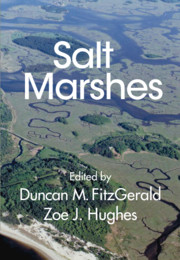Refine search
Actions for selected content:
7 results
22 - Biogeomorphology
-
-
- Book:
- Essentials of Geomorphology
- Published online:
- 12 November 2025
- Print publication:
- 23 October 2025, pp 477-494
-
- Chapter
- Export citation
Balancing conservation and human access to nature: the impact of a constructed causeway on water levels and sedimentation, North Bull Island, Ireland
-
- Journal:
- Cambridge Prisms: Coastal Futures / Volume 3 / 2025
- Published online by Cambridge University Press:
- 04 April 2025, e9
-
- Article
-
- You have access
- Open access
- HTML
- Export citation
IMPLICATIONS OF SINGLE-STEP GRAPHITIZATION FOR RECONSTRUCTING LATE HOLOCENE RELATIVE SEA-LEVEL USING RADIOCARBON-DATED ORGANIC COASTAL SEDIMENT
-
- Journal:
- Radiocarbon / Volume 64 / Issue 5 / October 2022
- Published online by Cambridge University Press:
- 10 August 2022, pp. 1139-1158
- Print publication:
- October 2022
-
- Article
- Export citation

Salt Marshes
- Function, Dynamics, and Stresses
-
- Published online:
- 19 June 2021
- Print publication:
- 22 April 2021
North Atlantic Climate–Ocean Variations and Sea Level in Long Island Sound, Connecticut, Since 500 cal yr A.D.
-
- Journal:
- Quaternary Research / Volume 53 / Issue 1 / January 2000
- Published online by Cambridge University Press:
- 20 January 2017, pp. 89-97
-
- Article
- Export citation
Late Holocene sea-level changes and isostasy in western Denmark
-
- Journal:
- Quaternary Research / Volume 66 / Issue 2 / September 2006
- Published online by Cambridge University Press:
- 20 January 2017, pp. 288-302
-
- Article
- Export citation
Rise and fall of mercury (Hg) pollution in sediment cores of the Thames Estuary, London, UK
-
- Journal:
- Earth and Environmental Science Transactions of The Royal Society of Edinburgh / Volume 105 / Issue 4 / December 2014
- Published online by Cambridge University Press:
- 09 September 2015, pp. 285-296
- Print publication:
- December 2014
-
- Article
-
- You have access
- Open access
- HTML
- Export citation
